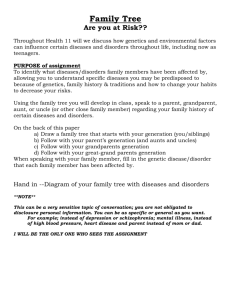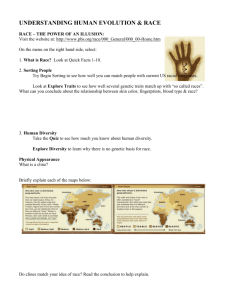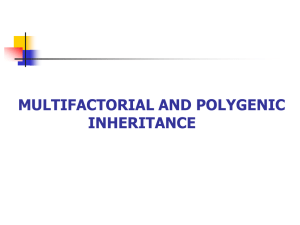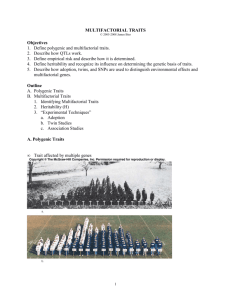Monogenic and polygenic heredity
advertisement
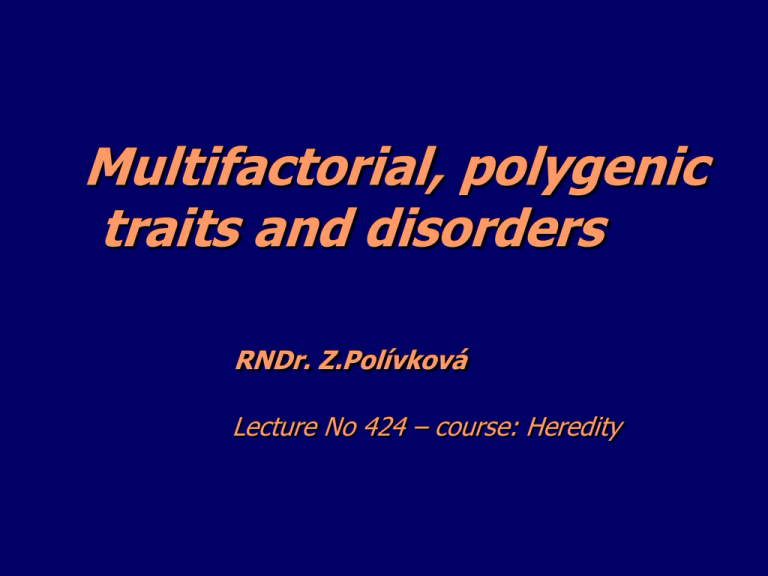
Multifactorial, polygenic traits and disorders RNDr. Z.Polívková Lecture No 424 – course: Heredity Polygenic heredity Polygenic = numerous genes at different loci with small additive effect Multifactorial = multiple genes are assumed to interact with environmental factors (complex inheritance) Quantitative = quantitative differences in traits 1. Normal traits with continuous variation – normal distribution – in population Gaussian curve – x = average value abnormal phenotypes = extreme variants of normal range traits: stature, intelligency, blood pressure 2. Isolated congenital malformations – multifactorial treshold traits sharp distinction between normal and abnormal phenotype s continuous variation in liability to the malformation treshold (in liability=sum of polygenes) divides population into unaffected and affected disorders: pyloric stenosis, neural tube defects : (anencephalus, spina bifida), congenital heart defects cleft lip and cleft palate 3.Disorders of adult life – important role of nongenetic factors - role of prevention coronary artery disease obesity diabetes mellitus schizophrenia manic-depressive psychosis allergy Scheme of multifactorial heredity environmental factors treshold polygenic system Role of environmental factors: Congenital malformations: prenatally (in organogenesis), teratogenic factors Diseases of adult life: postnatal environmental factors Characteristics of multifactorial heredity 1. The risk for first-degree relatives depends on population freguency (approx. the square root of the population risk) 2. The risk is sharply lower for second-degree relatives than for first-degree relatives and declines for more remote relatives 3. The recurrence risk is higher when more than one family member is affected (liability is high in such family, difference from mendelian traits) 4. The more severe malformation (disease), the grater reccurence risk (greater liability, more genetic factors) 5. If a multifactorial trait is more frequent in one sex than in the other, the risk is higher for relatives of patients of the less susceptible sex (higher liability) 6. Increased risk when the parents are consanquineous Cleft - dependance on the sex, expression Combination of sex and relevance of expression - cleft ♂ unilateral – less genetic factors, more environmental factors better possibility of prevention ♀ bilateral – more genetic factors, less environmental factors worse possibitity of prevention Calculation of risk: Edwards formula or empiric risks r = √ population frequency Example: cleft palate: population frequency = 0.0016 Risk for 1st degree relatives (if 1 person/parent is affected) = √0.0016 = 0.04 = 4% Empiric risk (from population studies) If both parents are affected - risk For 2nd degree relatives - risk For 3rd degree relatives - risk = 4.2% = 17% = 0.7% = 0.3% Possibilities of prevention Preconceptional care = only prevention of polygenic disorders • • • • • gynecologic care vitamin supplementation (folic acid …) adjustment of healthy state adjustment of life style protection against mutagens, teratogens … HERITABILITY = proportion of genetic variance to the total phenotypic variance (result of interaction of genetic and nongenetic factors in population) variance=statistical measure of how much an individual value is likely to vary from the mean of group Method of estimating of heritability from twins studies: monozygotic twins share 100% of their genes dizygotic twins share 50% of their genes Concordance = both members exhibit a certain trait CMZ - CDZ H= 100 - CDZ H = 0 – 0.2 H = 0.2 – 0.5 H = 0.5 – 1.0 low genetic determination, great role of environment mean genetic determination determination is primarily genetic, less succesfull prevention Prevention: by preconceptional care: till the risk 10% - is succesfull risk more then 10%: care after conception - ultrasound examination 0 100% Environmental factors Genetic determination 100% H=1 Monogenic disorders 0 H=0 Disorders caused by environmental factors only Teratogenesis Morphogenetic processes: - proliferation distribution and migration integration reduction Embryotoxic effect: death malformation growth retardation disturbance of function Sensitivity to teratogenes depends on : genotype of mother and embryo type and dose of teratogene ability of teratogene to go through placenta stage of pregnancy Critical period: period of development of morphogenetic system Sensitive period of teratogene: It is dependent on type and teratogen dose In overlapping of critical and sensitive periods → origin of congenital malformation Teratogenes: - generally cytotoxic - effect on proliferation - specific – need receptors Increased environmental pollution: frequency of malformation is stable, but spectrum of malformations is changed histogenesis implantation fertilisation embryogenesis 0 5- 6 days organogenesis 25 embryonal period all/nothing large malformations functional maturation birth 60 29 week fetal perinatal postnatal small malf. abnormality of functions (carcinogenesis) Teratogenes Physical: ionizing radiation, radioisotopes hypertermia (>39oC>2 days) Chemical: proved : vitamin A and its analogs in abundance cytostatics warfarin possible : antiepileptics lithium (psychofarmacs) hormons salicylates drugs : alcohol, smoking Biological: 1. viruses: rubella, small-pox, influenza, CMV 2. bacteria: Treponema pallidum – syphilis 3. parasites: Toxoplasma gondii (acute infection) Maternal factors: 1.nutrition: iodine, calcium, vitamin D, follic acid, protein malnutrition 2.diseases: diabetes mellitus, fenylketonuria, hypo(hyper)thyreosis, hypoxia Thompson &Thompson: Genetics in medicine,5th ed. Chapter 15: Genetics of disorders with multifactorial inheritance Chapter 17: Genetic aspects of development-Teratogens + informations from presentation http://dl1.cuni.cz/course/view.php?id=324
